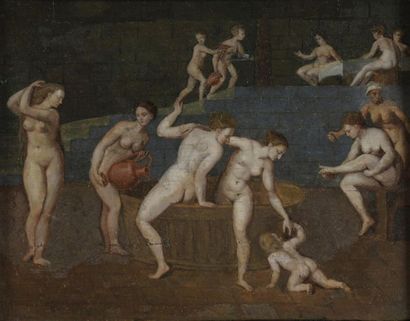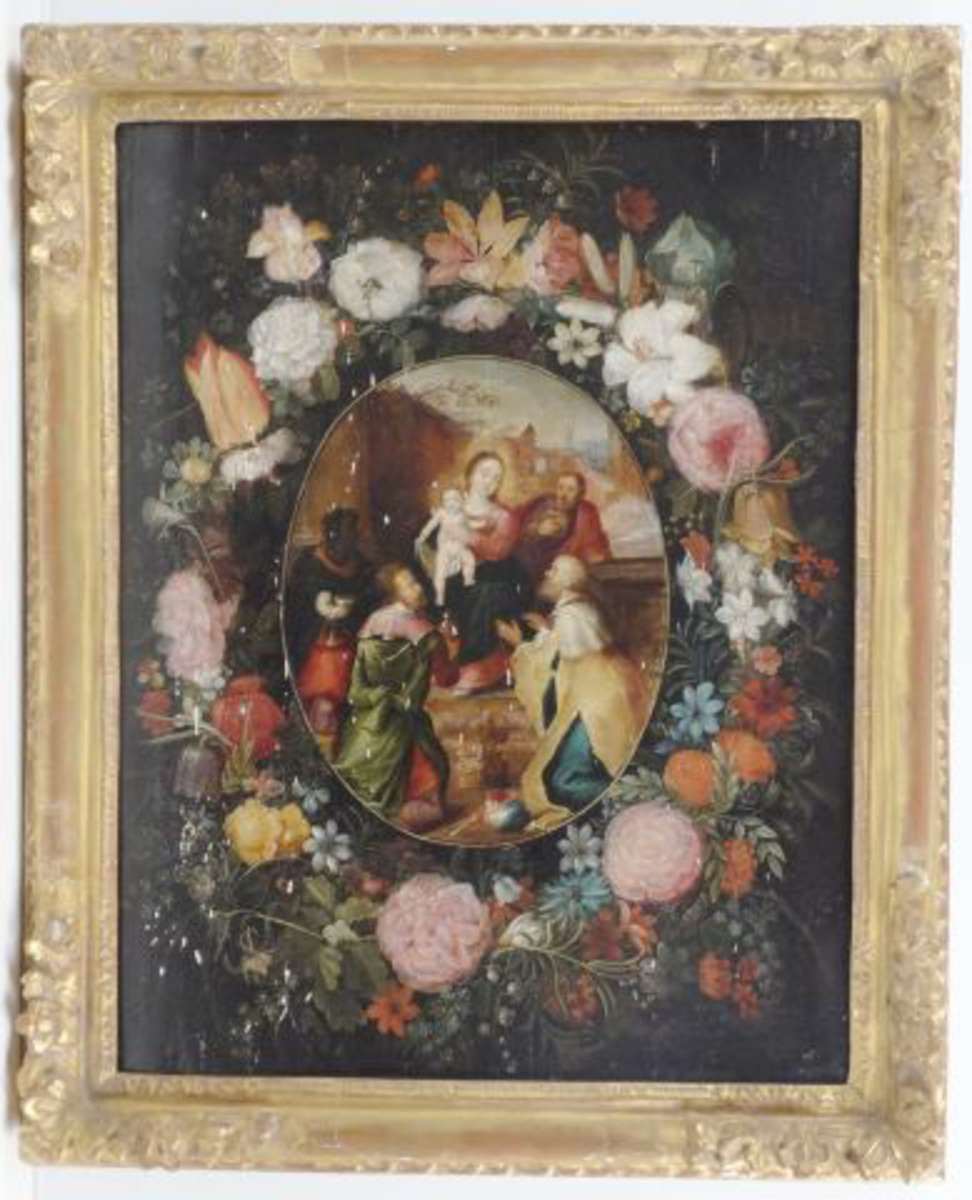Details
ÉCOLE FLAMANDE VERS 1570, ENTOURAGE D'ANTONIO MORO
Portrait en buste d'un homme barbu
huile sur panneau
63 x 42,2 cm. (24 3/4 x 16 1/2 in.)
Provenance
Probablement ancienne collection de l’archiduc Léopold-Guillaume (1614-1662), Bruxelles.
Collection particulière française depuis le milieu du XIXe siècle ; d'où acquis récemment par l'actuel propriétaire.
Post lot text
FLEMISH SCHOOL CIRCA 1570, BUST-LENGTH PORTRAIT OF A BEARDED MAN, OIL ON PANEL
This previously unpublished portrait is a significant rediscovery, and a fascinating addition to our understanding of the evolution of portraiture in Europe in the last third of the 16th century.
Depicted bust-length against a chromatically vibrant background that changes from dark brown to beige, the sitter is a man of advanced age, with full head of hair and beard, his face with strong features marked by deep and expressive wrinkles. In his simple black garment he presents a robust figure, though the hand he reveals displays a delicate transparency.
Shown in person or in photographic reproduction to several specialists and art historians of the period, a complete consensus was not reached as to the author of the present painting. However, all have unanimously acknowledged the high quality of the work and the complexity of comparing and attributing it to different artists.
With its pictorial power and delicate sensitivity, this portrait must be understood in relation to the masters of the genre who were active in the Netherlands and Flanders between 1570 and 1580. This was a particularly brilliant interconnected generation of artists of Dutch training, who worked in various European countries (the Netherlands, Flanders, Italy, Spain and England). Anthonis Mor (1516/1521-1576), an artist with whose work our painting has strong affinities, is widely acknowledge as the greatest of these. To this group should be added Peter Pourbus (1523 or 1524-1584), his son Frans Pourbus the Elder (154-1581), and Maarten de Vos (1532-1603), Frans Floris (1517-1570), these last two most famous for their religious scenes but nonetheless powerful portraitists, and the two Keys, Willem (1515/1516-1568) and Adrien Thomasz (c. 1544-after 1589).
The present painting can be productively compared with one of the most famous and enigmatic works of portraiture from this period: the Portrait of the artist Lambert Lombard (1505/1506-1566) in the Musée de l'Art Wallon, Liège (inv. no. 373).
Powerfully charismatic, this depicts the artist in three-quarter-length against a cream background. Although the identity of the sitter is not disputed (see the comparison with the engraving by Johannes Wierix (1549-1621) dated 1572, in C. Oger, Lambert Lombart, peintre de la Renaissance, Bruxelles, 2006, pp.335-336, cat. 2, fig. 291), the attribution is still uncertain (further underlining the complexity of expertise in this period, even where the greatest masterpieces are concerned). Though long considered to be a self-portrait by Lambert Lombard this hypothesis is now rejected in favour of either Frans Floris (see E. Wouk, The Life of Lambert Lombard Los Angeles, 2021, pp. 99-100) or Anthonis Mor (see C. Oger, 2006, idem).
From a technical point of view, a comparison of the two works reveals the same fine details in the execution of the hair and the beard; the same subtle and transparent workmanship, particularly in the treatment of the ears, a similar impasto in the white glazes that highlight the wrinkles and also the broad pentiments in the clothing (here seen in the hat, and in the sleeve in the Liège work). We would like to thank Cécile Oger, who agreed to a side-by-side comparison of the two paintings, and who argues in favour of reattributing both the Portrait of Lambert Lombard and the present painting to Anthonis Mor.
It is also instructive to place our painting within a wider context, and consider it in regard to the understanding of the period developed by Wouk in 2021 (E. Wouk, 2021, idem). Doing so indicates that this is clearly a more intimate portrait; it differs from the official portraits of religious or political dignitaries. The loose clothing and headdress might even suggest that the sitter is an artist and perhaps close to or familiar with the painter capturing his likeness. The artist evidently wanted to depict both the authority of his sitter as well as his kindliness and his good-nature, revealing a more sensitive psychological personality.
It is known that at the end of 1554 Anthonis Mor, on his return from Spain, went back to Holland. Over time, he began to paint more intimate portraits, endeavouring to capture the humanity of his sitters and often choosing to paint people he knew. The portrait of the painter Jan van Scorel (1495-1562), his master, signed and dated 1560 (Society of Antiquaries of London, London, inv. no. 338) is a good illustration of this shift in his working practice. In this vein, it is tempting to imagine that the sitter here might even be Peter Brueghel the Elder (ca. 1525-1569), whose features seem to be comparable and of whom no painted representation is currently known.
There is a final consideration, when thinking about the present painting in relation to Mor and his painting practice. Although no written source concerning the artist’s corpus mentions a portrait of an elderly man in bust form, a fairly precise document attests to the fact of at least one such work having existed; one of the paintings by David Teniers the Younger (1610-1690) representing the collection of Archduke Leopold-Guillaume (1614-1662) in Brussels (Prado Museum, Madrid, inv. no. P001813) depicts a very similar portrait to the present one. Seen between Teniers and Conde Fuensaldana (1603-1661), lieutenant and adviser to the Archduke, is the image of an elderly man with a beret, which could well be the present painting, even though the sketchiness of the image makes an exact comparison difficult. Interestingly however, the inscription "MORO" on the frame can be clearly seen.
Details
ÉCOLE FLAMANDE VERS 1570, ENTOURAGE D'ANTONIO MORO
Portrait en buste d'un homme barbu
huile sur panneau
63 x 42,2 cm. (24 3/4 x 16 1/2 in.)
Provenance
Probablement ancienne collection de l’archiduc Léopold-Guillaume (1614-1662), Bruxelles.
Collection particulière française depuis le milieu du XIXe siècle ; d'où acquis récemment par l'actuel propriétaire.
Post lot text
FLEMISH SCHOOL CIRCA 1570, BUST-LENGTH PORTRAIT OF A BEARDED MAN, OIL ON PANEL
This previously unpublished portrait is a significant rediscovery, and a fascinating addition to our understanding of the evolution of portraiture in Europe in the last third of the 16th century.
Depicted bust-length against a chromatically vibrant background that changes from dark brown to beige, the sitter is a man of advanced age, with full head of hair and beard, his face with strong features marked by deep and expressive wrinkles. In his simple black garment he presents a robust figure, though the hand he reveals displays a delicate transparency.
Shown in person or in photographic reproduction to several specialists and art historians of the period, a complete consensus was not reached as to the author of the present painting. However, all have unanimously acknowledged the high quality of the work and the complexity of comparing and attributing it to different artists.
With its pictorial power and delicate sensitivity, this portrait must be understood in relation to the masters of the genre who were active in the Netherlands and Flanders between 1570 and 1580. This was a particularly brilliant interconnected generation of artists of Dutch training, who worked in various European countries (the Netherlands, Flanders, Italy, Spain and England). Anthonis Mor (1516/1521-1576), an artist with whose work our painting has strong affinities, is widely acknowledge as the greatest of these. To this group should be added Peter Pourbus (1523 or 1524-1584), his son Frans Pourbus the Elder (154-1581), and Maarten de Vos (1532-1603), Frans Floris (1517-1570), these last two most famous for their religious scenes but nonetheless powerful portraitists, and the two Keys, Willem (1515/1516-1568) and Adrien Thomasz (c. 1544-after 1589).
The present painting can be productively compared with one of the most famous and enigmatic works of portraiture from this period: the Portrait of the artist Lambert Lombard (1505/1506-1566) in the Musée de l'Art Wallon, Liège (inv. no. 373).
Powerfully charismatic, this depicts the artist in three-quarter-length against a cream background. Although the identity of the sitter is not disputed (see the comparison with the engraving by Johannes Wierix (1549-1621) dated 1572, in C. Oger, Lambert Lombart, peintre de la Renaissance, Bruxelles, 2006, pp.335-336, cat. 2, fig. 291), the attribution is still uncertain (further underlining the complexity of expertise in this period, even where the greatest masterpieces are concerned). Though long considered to be a self-portrait by Lambert Lombard this hypothesis is now rejected in favour of either Frans Floris (see E. Wouk, The Life of Lambert Lombard Los Angeles, 2021, pp. 99-100) or Anthonis Mor (see C. Oger, 2006, idem).
From a technical point of view, a comparison of the two works reveals the same fine details in the execution of the hair and the beard; the same subtle and transparent workmanship, particularly in the treatment of the ears, a similar impasto in the white glazes that highlight the wrinkles and also the broad pentiments in the clothing (here seen in the hat, and in the sleeve in the Liège work). We would like to thank Cécile Oger, who agreed to a side-by-side comparison of the two paintings, and who argues in favour of reattributing both the Portrait of Lambert Lombard and the present painting to Anthonis Mor.
It is also instructive to place our painting within a wider context, and consider it in regard to the understanding of the period developed by Wouk in 2021 (E. Wouk, 2021, idem). Doing so indicates that this is clearly a more intimate portrait; it differs from the official portraits of religious or political dignitaries. The loose clothing and headdress might even suggest that the sitter is an artist and perhaps close to or familiar with the painter capturing his likeness. The artist evidently wanted to depict both the authority of his sitter as well as his kindliness and his good-nature, revealing a more sensitive psychological personality.
It is known that at the end of 1554 Anthonis Mor, on his return from Spain, went back to Holland. Over time, he began to paint more intimate portraits, endeavouring to capture the humanity of his sitters and often choosing to paint people he knew. The portrait of the painter Jan van Scorel (1495-1562), his master, signed and dated 1560 (Society of Antiquaries of London, London, inv. no. 338) is a good illustration of this shift in his working practice. In this vein, it is tempting to imagine that the sitter here might even be Peter Brueghel the Elder (ca. 1525-1569), whose features seem to be comparable and of whom no painted representation is currently known.
There is a final consideration, when thinking about the present painting in relation to Mor and his painting practice. Although no written source concerning the artist’s corpus mentions a portrait of an elderly man in bust form, a fairly precise document attests to the fact of at least one such work having existed; one of the paintings by David Teniers the Younger (1610-1690) representing the collection of Archduke Leopold-Guillaume (1614-1662) in Brussels (Prado Museum, Madrid, inv. no. P001813) depicts a very similar portrait to the present one. Seen between Teniers and Conde Fuensaldana (1603-1661), lieutenant and adviser to the Archduke, is the image of an elderly man with a beret, which could well be the present painting, even though the sketchiness of the image makes an exact comparison difficult. Interestingly however, the inscription "MORO" on the frame can be clearly seen.















Testen Sie LotSearch und seine Premium-Features 7 Tage - ohne Kosten!
Lassen Sie sich automatisch über neue Objekte in kommenden Auktionen benachrichtigen.
Suchauftrag anlegen